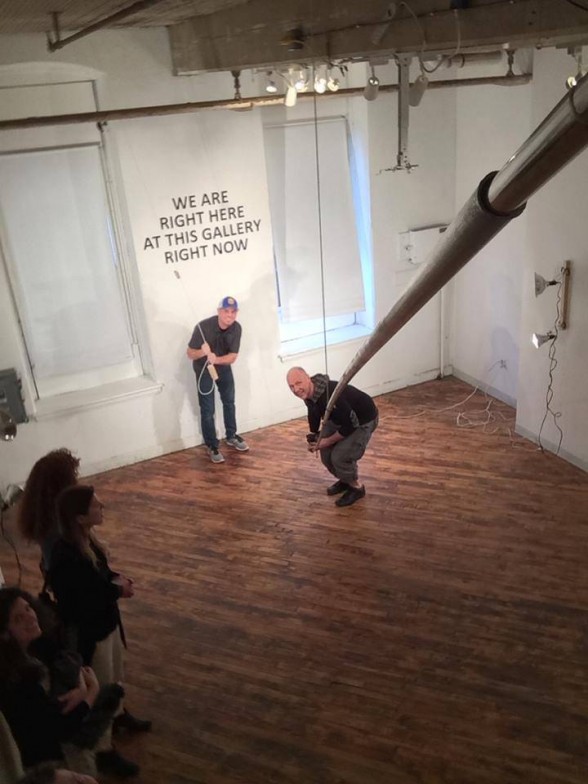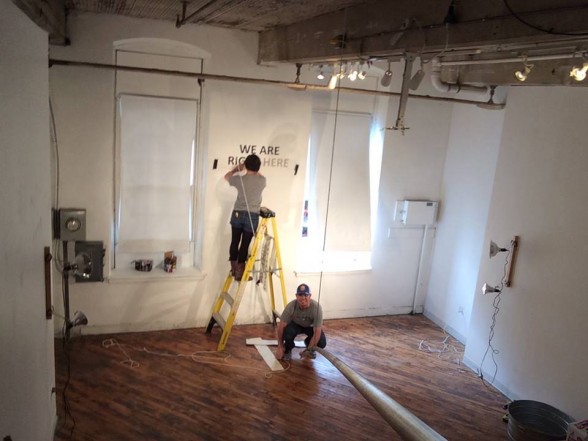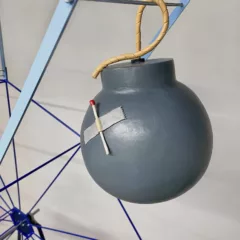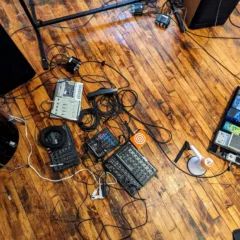[Marvin experiences selfies in a different context–or perhaps out of context completely. — the Artblog editors]
Strike a pose at Practice Gallery with experimental artist Lee Walton’s self-proclaimed The World’s Longest Selfie Stick.
The device, which measures approximately 30 feet long, is the only piece on display in the small gallery. Yet, as simple of a concept as it is, the work on its own evokes ideas of time and space in relation to instant photography and identity in the digital age.
Say cheese
Walton’s “selfie” stick combines a commercial portable Flexion Selfie Stick–a mounting piece for your camera-enabled smartphone with a wireless Bluetooth shutter button–and is attached to an aluminum tube extension. Walton has also installed a pulley system made out of rope and a small block of wood, which allows the visitor to maneuver their phone to their preference. Black vinyl lettering set against the gallery’s white wall reads, “WE ARE RIGHT HERE AT THIS GALLERY RIGHT NOW”. This setup serves as the visitor’s photo background. After a quick press of a button, you have a snapshot that captures a full-body portrait.

The entire experience is whimsical and perplexing. According to gallery staff, every visitor, young and old, has reacted differently. Despite that, most visitors already have a preconceived idea of what a selfie is.
The conspicuously placed contraption hangs at the center of the gallery. There are also four spotlights angled directly at the adjacent wall across the entrance. Visitors are welcomed to their own photo shoot. The visitor now becomes both the subject and the photographer, and literally takes control of their frame. Do you take a solo portrait, or invite your friends to be part of a group picture? Do you take a vertical or horizontal photo? The instantaneous moment of taking a photo and uploading the image to social media websites gives even more ownership to the person behind the “lens”. But what does this all say about us?

The word “selfie” has become ubiquitous in pop culture and contemporary vocabulary. A selfie is nothing more than a self-portrait. There is sheer narcissistic joy in taking a photograph of yourself and presenting it to your family and friends. With the advent of technology and mobile phones, selfies allow us to immediately show our mood and capture our existence at a certain time or place.
Remarkably unremarkable results

What Walton’s piece accomplishes that most selfies do not is showing the viewer the subject’s surrounding environment. For the most part, a traditional selfie usually is taken at arm’s length, which cuts out most of the active space around an individual in order to focus more on the actual subject. By doing this, a selfie also crops the subject’s body, often creating a distorted photo.

Walton’s selfie stick reconsiders the practice of taking self-portraits via camera phones by expanding the constricted frame space into a wider perspective. The new point of view, however, shifts the quality of the photo to a more distant–even voyeuristic–shot.
Interestingly, this selfie stick has only been used indoors. In an era where people are photographing themselves at famous landmarks and historical sites, Walton has chosen to keep his selfie stick in the confines of Practice’s walls. The idea of displaying ourselves at areas deemed culturally significant says a lot about how we want people to perceive us. By offering the opportunity to take a selfie in a barren, white-walled, empty gallery, perhaps Walton is suggesting that this setting ultimately does not represent a bona fide, glossy selfie. Instead, we are left with a rather an unmemorable, ordinary photo.
The World’s Longest Selfie Stick is on view at Practice Gallery through May 31, 2015.









